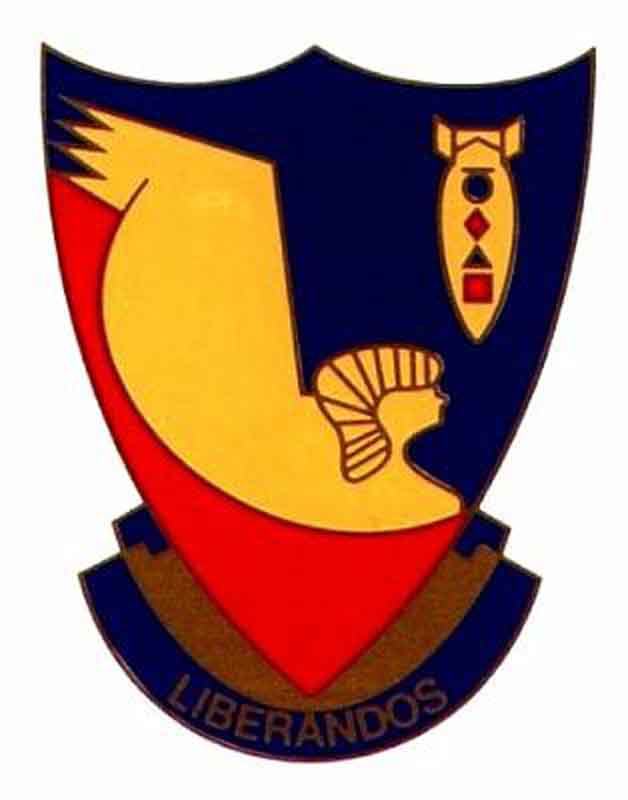A Brief History
Following the 7 December 1941 attack on Pearl Harbor, President Franklin D. Roosevelt ordered the Army Air Forces to mount retaliatory raids on the Japanese home islands. A task force, commanded by Colonel Harry E. Halverson and composed of 231 officers and enlisted men and 23 B-24D Liberator bombers, was assembled at Fort Myers, Florida. The unit was given the code name "HALPRO" for Halverson Project. This organization, destined to be the parent unit of the 376th Bombardment Group, departed the United States on 20 May 1942 to begin attacks on Japanese targets from a base located in China. When HALPRO arrived in the Middle East, the unit learned that its' proposed base had been captured by Japanese forces. To make matters worse, the German Afrika Korps under General Erwin Rommel was poised to attack Allied forces in North Africa.
HALPRO was quickly diverted from its' original mission to a new one: interdictory raids from airfields in Egypt against shipping and North African ports supporting Axis operations. On 20 June 1942, the Halverson Project was dissolved and the organization was renamed the First Provisional Bombardment Group. In subsequent organizational change, all First Provisional personnel and B-24s were transferred to the newly activated 376th Heavy Bombardment Group. The order became effective on 31 October 1942 and as a subsequent gesture of unit identity, members of the 376th adopted the nickname "Liberandos". Rapid build-up of personnel and aircraft in early 1943 resulted in the formation of a fully formed group composed of the 512th, 513th, 514th and 515th Squadrons.
Attacks by the fledgling 376th, the first heavy bombardment group to operate in the Middle East Theater, were focused on Axis supply lines between Italy and North Africa, airfields, and port facilities. Later, longer range raids were made against oil refineries, marshalling yards, and ordinance factories in Hungary, Austria, Czechoslovakia and Yugoslavia. The Liberandos were also chosen to lead four other B-24 bombardment groups on the daring 1 August 1943 low level raid against Romania's Ploesti Oil Fields. After the liberation of North Africa late in 1943, the Group moved to San Pancrazio, Italy where it participated in an accelerated campaign against Axis targets in southern Europe and the Balkans. Group sorties extended as far as Vienna, Austria and Regensburg, Germany.
During four years of operations, the 376th and its parent units became integral elements of the 9th, 12th, and 15th Air Forces. The Group flew 451 missions, was awarded three Distinguished Unit Citations and earned 15 campaign awards. The Liberandos destroyed 220 enemy aircraft in aerial combat and suffered casualties totalling 1479 officers and enlisted personnel and 169 aircraft.
- James W. Walker
Emblems
Squadrons
Distinguished Unit Citations
Battle Stars
- Air Combat, EAME Theater
- Northern France
- Po Valley
- Rhineland
- Rome-Arne
- Sicily (air)
- Southern France
- Tunisia (air)
- Air Offensive, Europe
- Anzio
- Central Europe
- Egypt-Libya
- Naples-Foggia (air)
- Normandy
- Northern Apennines
Group Firsts
- Oldest Bomb Group operating overseas
- 1st Bomb Group over Ploesti, High Altitude 6/12/42
- 1st USAAF Bombers to hit Italian Fleet, 6/15/42
- 1st over Naples, 12/4/42
- 1st Rome Raid, 7/19/43
- 1st over Ploesti Operation Tidalwave, 8/1/43
- 1st over Wiener-Neustadt, 8/13/43
- 1st Heavy Bomb Group to be based on European Continent
- 1st Bomb Group to bomb European Continent
Group Commanders
HALPRO

1st Provisional Bombardment Group
20 July, 1942 to 7 August, 1942
1st Provisional Group

20 July, 1942 to 7 August, 1942

7 August, 1942 to 31 October, 1942
376th Bombardment Group

31 October, 1942 to 19 February, 1943

19 February, 1943 to 20 February, 1943

20 February, 1943 to 9 January, 1944

Lt. Col. Theodore Q. Graff,
9 January, 1944 to 10 July, 1944

10 July, 1944 to 27 September, 1944

Colonel Theodore Q. Graff,
27 September 1944 to 22 February, 1945

Colonel Robert H. Warren,
22 February, 1945 to September, 1945

The website 376bg.org is NOT our site nor is it our endowment fund.
At the 2017 reunion, the board approved the donation of our archives to the Briscoe Center for American History, located on the University of Texas - Austin campus.
Also, the board approved a $5,000 donation to add to Ed Clendenin's $20,000 donation in the memory of his father. Together, these funds begin an endowment for the preservation of the 376 archives.
Donate directly to the 376 Endowment
To read about other endowment donation options, click here.
Reunion
NOTE change in the schedule !!
DATES: Sep 25-28, 2025
CITY:Rapid City, SD
HOTEL: Best Western Ramkota Conference Hotel; 2111 North LaCrosse St., Rapid City, SD 57702; 605-343-8500
Click here to read about the reunion details.



















